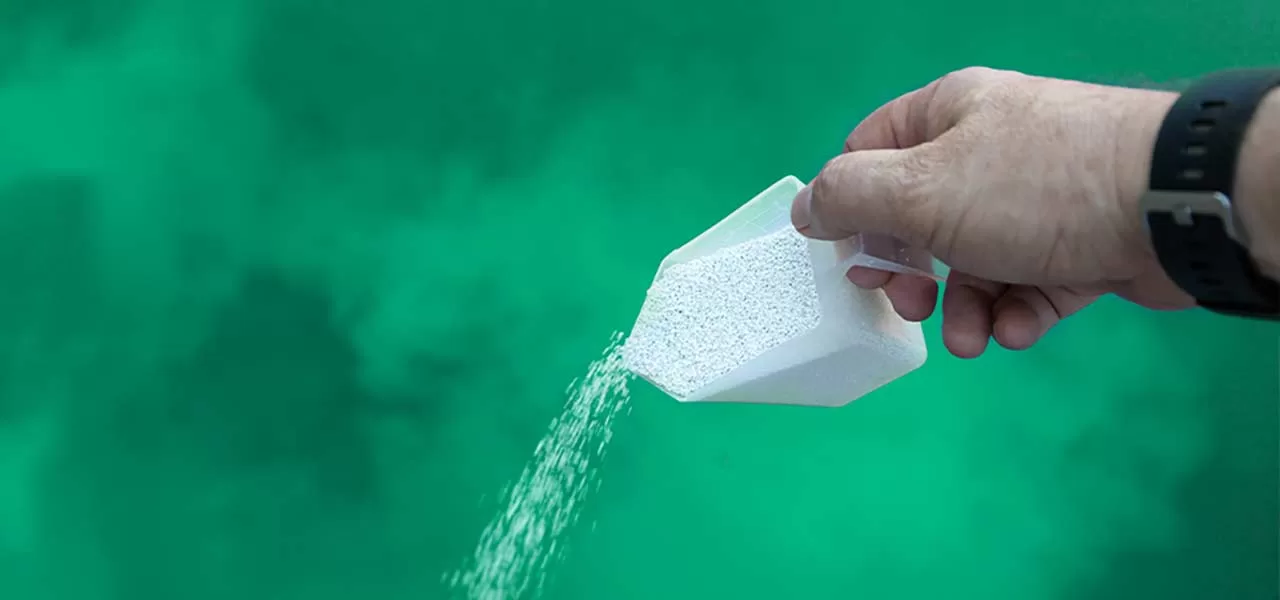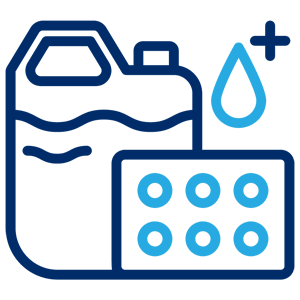FREE Standard Shipping On All Orders $100 or More!*

Pool Shock: Shocking for Algae Removal
Unless you're an alligator, it's safe to assume you don't want to be swimming around in algae. But if you do, we won't judge! However, for everyone else, an abundance of algae in your swimming pool is the stuff of nightmares. Thankfully, algae has enemies — algaecide and cal-hypo (calcium hypochlorite) shock! These two chemicals are excellent at removing and preventing the growth and spread of algae. So if you don't feel like floating through a swamp, keep reading to learn about pool algae removal and prevention.
Types of Pool Algae
One size does not fit all when it comes to algae. There are three types of algae that can develop and wreak havoc in your pool. Identifying what sort of algae you have will help determine how hard it will be to eradicate.
Green Algae
Green algae is what most people imagine when they think of algae. It is the most common variety found in pools, and it is also the easiest algae to kill. However, green algae spreads rapidly, and can go from bad to worse overnight. Assessing the color of the algae in your pool will give you an idea of how difficult it will be to eliminate.
- Light Green/Teal: At this stage, the algae is just beginning to bloom, and can be removed with relative ease.
- Medium Green: This color indicates significant algae growth, and removal is more challenging.
- Dark Green: If the algae progresses to this color, you have your work cut out for you! When algae progresses to this stage, it is much more challenging and time consuming to eliminate.
Yellow Algae
Also known as mustard algae, yellow algae is less common than its green cousin. Yellow algae is typically found in humid climates, and unfortunately, it is usually chlorine resistant. This form of algae often looks like dirt or sand sitting on the bottom of your pool. But don’t let that fool you. Ridding your pool of yellow algae is a bit more laborious than vacuuming up dirt.
Black Algae
Black algae is not a fun, or easy pool dilemma to deal with. While black algae itself is not exactly harmful to swimmers, its presence indicates your pool is not doing its job regarding bacteria prevention. It is also very hard to get rid of, due to its deep roots and resistance to chlorine.

Materials Needed for Pool Algae Removal
Gather up your supplies and get ready for some algae wrangling! Below are the tools and materials you will need to successfully rid your pool of its troublesome tenants.
How to Remove Pool Algae
Now that you have your supplies, and have identified what form of algae is in your pool, let’s dive into the steps for removing and preventing swimming pool algae.
1. Clean or Backwash Filter
This one is pretty self-explanatory. Before you add any chemicals, make sure your pool filter is clean, and clear of any debris.
2. Run Pump
Run your pool pump for about 36-48 hours during the algae treatment process.

3. Balance Water
Since you will add strong chemicals into your pool to treat the algae, you need to make sure the other pool chemicals are adjusted accordingly.
- pH: 7.8 or higher
- Total Alkalinity: 80-100 ppm for cal-hypo shock
- Cyanuric Acid: 25-75 ppm
4. Brush Pool
Brushing your entire pool prior to adding the chemicals is critical. The algae will loosen and break apart when you brush it, making it much more vulnerable to the algaecide and shock.
PRO TIP: Leave your brush in the pool during the treatment process. This will knock out any algae particles on the brush.
5. Add Algaecide
Choose the appropriate algaecide, depending on what type of algae is in your pool. If you prefer to use a metallic-free algaecide, opt for Algaecide 60 Plus. Distribute the algaecide around the entire perimeter of your pool, adding extra to problem areas.

6. Shock
After letting the algaecide settle for a few minutes, shock your pool with cal-hypo shock. We recommend using our Super Pool Shock, which contains 73% chlorine. Use a pound of shock for every 15,000 gallons of pool water. Depending on the severity of the algae, you will likely have to shock twice, if not three times.
Wait 12 hours between each shock treatment.
7. Test Pool Water
Your pool just got quite a shock to the system, literally, so it’s important to check chemistry levels after algae treatment. Make sure pH, Total Alkalinity, chlorine, phosphates, and calcium hardness are all within their designated ranges.
8. Backwash or Clean Filter
Set your filter to backwash to thoroughly expel any contaminated water or algae particles. This is an important step, if you don’t flush out your pool filter, algae particles can creep their way back into your pool!
9. Vacuum and/or Add Clarifier
If your pool water looks murky and dirty after all that time and effort defeating the algae, don’t worry. There are likely to be dead algae particles floating around in your pool after treatment. Vacuum your pool to waste — or use a clarifier — to clean up, and clear up your pool.
Steps for Preventing Algae
Now that you have seen the time and energy that goes into algae removal, follow these steps to prevent it in the first place.
- Test and balance your pool water once a week. Additional testing is advised after heavy use.
- If your pool is used frequently, shock it at least once a week.
- Clean or backwash your filter regularly.
- Run your pool pump for at least 10 hours per day to completely circulate the water.
- Keep your phosphate levels below 100 ppb (parts per billion).
Don't let algae-filled, swampy water ruin your pool time! We hope this comprehensive guide has helped you understand how to successfully tackle pool algae removal and prevention.